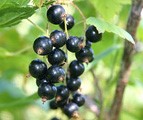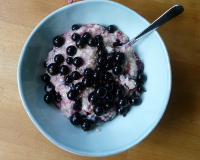Black currants nutrition facts Incredibly rich in numerous health benefiting phyto-nutrients and anti-oxidants, black currants are indeed one of the very popular summer season berries. Currants are native to central and northern Europe and Siberia. Currant is a small shrub belonging to the family of Grossulariaceae, of the genus; Ribes and has the scientific name: Ribes nigrum. In general, currants grow best in regions where summer is humid but winter is severe and chilling. It is a fast growing, deciduous, small shrub reaching about 5-6 ft tall.
 |
 |
| Black currants (Ribus nigrum). | Red currants. |
During each season, the shrub bears pendulous chain of small berries During each season, the shrub bears pendulous chain of small berries. The fruit has size of about 1 cm in diameter, very dark purple, almost black, with a glossy skin and a persistent calyx at the apex, and containing 3-10 tiny seeds. Berries of red, white and pink currants are translucent, sweeter in taste, but less nutritional than black varieties. Health benefits of black currants
- Black currants have significantly high amounts of phenolic flavonoid phytochemicals called anthocyanins. Scientific studies have shown that consumption of blackcurrants have potential health effects against cancer, aging, inflammation, and neurological diseases.
- Black currants have anti-oxidant value (Oxygen radical absorbance capacity- ORAC) of 7950 Trolex Equivalents per 100g, which is one of the highest value for fruits after chokeberries, elderberry, and cranberries. Red currants, however, possess comparatively less ORAC value at 3387 TE than the black variety.
- These berries are an excellent source of antioxidant vitamin,vitamin-C. 100 g of fresh currants provide more than 300% of daily-recommended intake values of vitamin C. Research studies have shown that consumption of fruits rich in vitamin C helps the body develop immunity against infectious agents and also help scavenge harmful oxygen-free radicals from the body.
- Black currants are very good in vitamin A, and flavonoid anti-oxidants such as beta-carotene, zea-xanthin and cryptoxanthin levels. 100 g fresh berries provide 230 IU of vitamin A. These compounds are known to have antioxidant properties. Vitamin A is also required for maintaining integrity of mucus membranes and skin, and essential for healthy eye-sight. Furthermore, consumption of natural fruits rich in flavonoid anti-oxidants helps to protect from lung and oral cavity cancers.
- Fresh blackcurrants are also rich in many essential vitamins such as pantothenic acid (vitamin B5), pyridoxine (vitamin B-6) and thiamin (vitamin B-1). These vitamins are essential in the sense that body requires them from external sources to replenish and required for metabolism.
- They also contain good amounts of mineral iron. 100 g currant berries provide about 20% of daily recommended levels. Iron is an important co-factor for cytochrome oxidase guided cellular metabolism. It is also required for red blood cell (RBC) production in the bone marrow.
- Additionally, the berries are also a very good source of other important minerals like copper, calcium, phosphorus, manganese, magnesium, and potassium, which are very essential for body metabolism.
See the table below for in depth analysis of nutrients: Black currants (Ribus nigrum), Nutrition Value per 100 g. ORAC Value (Anti-oxidant level) 7950. (Source: USDA National Nutrient data base)
| Principle | Nutrient Value | Percentage of RDA |
| Energy | 63 Kcal | 3% |
| Carbohydrates | 15.38 g | 12% |
| Protein | 1.4 g | 2.5% |
| Total Fat | 0.41 g | 2% |
| Cholesterol | 0 mg | 0% |
| Dietary Fiber | 4.3 g | 11% |
| Vitamins | ||
| Folates | 8 µg | 2% |
| Niacin | 0.300 mg | 2% |
| Pantothenic acid | 0.398 mg | 8% |
| Pyridoxine | 0.066 mg | 5% |
| Riboflavin | 0.050 mg | 4% |
| Thiamin | 0.050 mg | 4% |
| Vitamin A | 230 IU | 7.5% |
| Vitamin C | 181 mg | 301% |
| Electrolytes | ||
| Sodium | 2 mg | 0% |
| Potassium | 322 mg | 7% |
| Minerals | ||
| Calcium | 55 mg | 5.5% |
| Copper | 0.086 mg | 9.5% |
| Iron | 1.54 mg | 19.5% |
| Magnesium | 24 mg | 6% |
| Manganese | 0.256 mg | 11% |
| Phosphorus | 59 mg | 8.5% |
| Zinc | 0.27 mg | 2% |
Selection and storage Black currants season lasts from July until October. If the fruits are to be stored at all, they should be picked dry. Damaging the fruits can be avoided by picking up the whole string by its stem, taking care not to damage the spur. Fresh currants feature deep-purple, almost black, with a glossy skin and a persistent calyx at the apex. Avoid berries that are soft, shriveled skin and with cuts/bruises with leaking juice. If not used immediately, store them in the refrigerator where they keep fresh for several days. Preparation and serving methods Wild currants that are picked up from their natural habitat can be consumed directly. While purchasing from the stores, choose berries with uniform surface and color. Wash them in cold water just prior to use to keep their texture intact. Here are some serving tips:  Black currants topped porridge. Photo: storebukkebruse
Black currants topped porridge. Photo: storebukkebruse
- Raw, fresh or dried currants can be eaten all alone as snacks; especially red, pink and white varieties which are sweeter and delicious.
- Tart, astringent quality black currants are favored in many culinary dishes, especially boiled and pureed, across Europe.
- They give refreshing taste when added in fruit cocktails.
- Black currants are being used in the preparation of muffins, pie fillings, and ice creams.
- The berries are used in food industry in preparation of sauce, jam, jelly.
- The berries are also used in flavored drink production.
